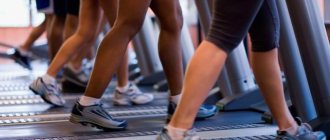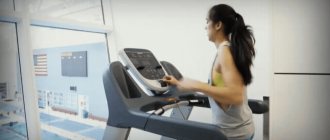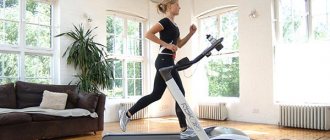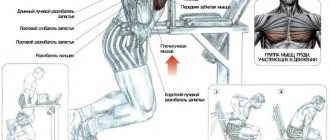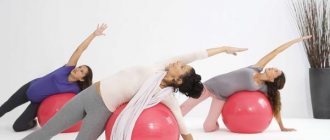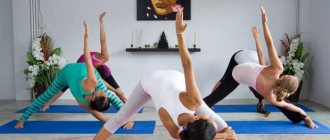Running is the most common sport. There are many types of running and ways to use it. Often, when a person is overweight or wants to train his body, he uses this sport as the easiest way to achieve his goal.
It happens that there is no opportunity or desire to conduct street training (there are no suitable places, bad weather, classes are held in the gym). Then a treadmill will help.
But in this case, another problem may arise - how to practice it correctly? You can find answers to this question and many others in this article.
Security measures
Walking is an ideal way to get started. Walking can be done even with serious contraindications to sports. I recommend reading this post about walking.
Please note that this does not relieve you of the need to talk to your doctor before starting classes. Things like spinal curvature, flat feet, problem joints, infectious diseases, etc. must be taken into account and treated with special methods. Fitness is not medicine, remember that. The best path to health and slimness is a reasonable combination of medical care and fitness. Why abandon the achievements of modern medicine? They greatly simplify life, eliminating current diseases and their possible delayed consequences.
About the treadmill
Modern cardio equipment amazes with its variety and technology. But the basis of classes on them is always built on ordinary physics, taking into account the laws of the physiology of the body. Here we always deal with concepts such as work, intensity, power, heart rate, duration, etc. That is, with specifically measurable concepts.
A treadmill in English is called a treadmill, which literally means “device for walking.” We call it a treadmill. Actually, this is a walking machine that you can run on.
The main components of the treadmill are the control panel and the running belt along which you need to walk.
Treadmill
The remote control may look very complicated, but in reality its main functions are:
- Change the driving speed using two keys (increase and decrease).
- Changing the angle of the running tape using two keys (up and down).
- Start and stop buttons.
The remote control panel may contain a lot of other buttons (fan, activation of special built-in programs, load monitor, information about the distance traveled, heart rate, inclination angle, etc.). And, frankly, no serious coach uses most of these options.
Treadmill remote control
If you work out in a gym, ask a trainer to teach you how to use the basic functions of the machine (speed, incline, on and off). If you train at home, carefully study the instructions for the simulator.
And please treat the “calorie burnt counter”, the amount of fat burned, the percentage of body fat with a certain amount of humor. This is one of the most useless functions and has almost no relation to reality.
How to run properly[edit | edit code]
Treadmill training programs
Running technique. While doing exercises on the treadmill, your shoulders and chest should be straightened and your abs tense. The arms are also included in the work: they are bent at the elbows at a right angle and act in the opposite direction, which increases blood flow. Move smoothly, gradually increasing the pace from slow to fast. Read more:
running technique.
Breath.
Breathe deeply through your nose.
Best time to train.
The debate about whether it is healthier to run in the mornings or evenings has been raging for a long time. If you have time in the morning, start the day with a cold or contrast shower and a run on the treadmill. This will energize you for the long day and will rev up your metabolism to earn carbs for breakfast. An evening run will allow you to relieve stress and calm your mind, in addition to all the other effects of running. Whatever time you choose to exercise on the treadmill, it is definitely healthier than lying on the couch.
Heart rate zone for fat burning[edit | edit code]
To calculate the effective heart rate zone for an adult, during exercise in which the muscles work and the fat burning process occurs, a special formula is used:
“220 minus (number of years)” or “200 minus (years after 20 years)”
Once you've calculated your maximum heart rate for your age (if you're 40, it's 180 beats per minute), you can determine your effective zone. In this example, this is 65 - 85% of the maximum, that is, from 180x0.65 to 180x0.85 = 117-153. It is better for you not to cross the boundaries of this zone: if the pulse is higher, there is a risk of overload, if lower, the effect of training on the treadmill will be minimal. Remember your effective heart rate and try to stay within its limits during cardio. But be careful: If you're 40 and this is your first cardio workout since college football, choose a gentler regimen.
Duration of training[edit | edit code]
Due to the physiological characteristics of the body, it is important that your training is long enough. You can exercise with a heart rate slightly below the effective zone, but in this case your training on the treadmill should be longer by 20-30 minutes, ideally from 40 minutes to 1 hour. The optimal amount of training on a treadmill is 3 times a week. If you exercise more often, the body simply will not have time to recover and such loads will not bring benefits. And a weight loss program consisting of 1-2 workouts per week is practically useless (unless you supplement it with strength training).
Treadmill exercises[edit | edit code]
Walking
It has an almost miraculous effect. In addition to accelerating the fat burning process, walking can relieve tension while simultaneously working all muscles. A minimum of 30 minutes of vigorous walking a day, either outside or on a treadmill, will help you maintain cardiovascular and respiratory health.
Run
The benefits of running on a treadmill are literally legendary. This type of cardio is the most popular, and is truly addictive - in the good sense of the word. If the first runs may give you mixed feelings of reluctance and laziness, then over time running training will be a joy.
Sprint
Allows you to get the most out of your potential. This type of treadmill workout requires you to push yourself to the limit, but also burns calories at full capacity.
Inclined
This is the easiest way to make your workout more challenging. By changing the incline angle, you contribute to even faster weight loss during workouts on the treadmill. Today, a method based on alternating walking at an incline and walking at a certain speed is increasingly gaining popularity in the niche of cardio training. And for good reason: regular exercise of this type really allows you to get your figure into the desired shape in a short time.
Speed
The main enemy of training effectiveness is monotony. There is only one way to avoid tedious exercise - by turning your treadmill workout into a game of speed. By alternating between jogging and walking, or walking and running at top speed, you'll get more fun and better results from your treadmill workout.
Interval training on the treadmill
If you accept the rules of the speed game mentioned above and include alternating rest and acceleration in your workouts, you can lose weight many times faster. This type of training is called interval training, it is distinguished by the duration of the intervals: limited in time or lasting as long as you have the strength.
Clearly timed intervals in training on a treadmill can be different, for example, 1 minute of sprint, 2 minutes of recovery, or 4 minutes of intense running with an incline, rest - 7 minutes. Planning for such an interval cardio workout on a treadmill depends on your physical fitness and cardiovascular health.
Interval training on a treadmill that does not have clear intervals is called “fartlek”, from the Swedish fartlek - “speed game”. This type of training involves running at full strength until failure, to use bodybuilding terminology. Once your strength is gone, take a recovery break, walk, and then run again at top speed. The most important thing for weight loss in this type of training on the treadmill is to work at your limit during the speed segment. Give it your all, stopping only when you no longer have the strength.
Whichever treadmill interval training program you choose, you'll notice results soon: it's been proven that calories continue to be burned even after the workout ends. set of exercises on a treadmill
What are handrails used on a treadmill?
A modern treadmill has handrails on either side of the control panel. Handrails may have sensors (these are metal parts of the handrail that you need to place your palms on) that allow you to monitor your heart rate and control buttons. To determine your pulse using such a sensor, you need to hold it with your hands for several minutes (not seconds!).
Handrails are convenient if you suddenly lose your balance. You can immediately grab them and adjust your body position.
Treadmill handrails
However, you should not walk constantly holding onto the handrails and, especially, leaning on them, shifting part of your weight onto them. This removes a significant part of the much-needed load from you and leads to a decrease in the effectiveness of the workout. Therefore, do not “hang” on the handrails, but “carry” yourself. It is important.
There's nothing funnier than watching a person hanging with all his weight on the handrails of a treadmill, but trying hard to burn as many calories as possible by racking up the miles...
Errors during classes
Everyone makes mistakes, not just newbies. Sometimes even experienced people do something wrong. Let's list the most common of them:
- The center of gravity is shifted, the load that should be placed on the legs goes to the arms and spine, and the entire skeletal system suffers.
- The quantity and duration do not increase over time and remain in one place. The body should feel a gradual increase in intensity.
- A sharp start and difficult tasks. Don't start at your limit.
- Training during illness. This is a big plus for willpower and a minus for overall well-being.
- Place your feet on a standing surface. You can only move with the exercise machine, and before that you can stand on the sides.
- Without shoes or wearing inappropriate clothing. Barefoot only seems comfortable, but in reality the toe and heel become too tired and strained. And the suit must be suitable - it is better to use equipment from Stayer than to endure sticky sweat on your back in the first 3 minutes of your run.
Walking on a treadmill. Safety regulations.
Be sure to hold onto the handrail before turning on the treadmill. Once you start walking, make sure you are walking steadily and balanced, then release the handrail. If you do not feel stability and balance, hold on to the handrail, but do not “hang” on it.
If you have long hair, you should collect and style it during training. This will protect you in case of a fall.
Smoothly start moving on the track and finish it smoothly using the appropriate buttons.
If you experience dizziness, nausea, chest pain or other unpleasant symptoms while walking, you should stop walking and consult a doctor.
Don't be tempted to immediately use the "super-fancy", "super-interval" and other built-in programs, even if your trainer recommends them. You are a beginner and this is not for you right now. By avoiding basic exercise in the form of walking, you are putting your health at great risk. This risk is not justified, believe me. In addition, in just 2-4 weeks your heart will become stronger, and you will be able to train more intensely, using more serious training methods. Haste will ruin everything.
Don't exercise in a draft. There is nothing more offensive than getting pinched in the neck or lower back due to local cooling of the neck or back (a T-shirt wet from sweat and a draft).
Basic training program
Programs may vary and this option may not be the best for you. However, this program is very versatile and can be used with other training options on the day of jogging or on free days, and as a separate training.
Carefully! When you use a training program, evaluate your body's symptoms and monitor the load.
Excessive fatigue or dizziness are negative signs; the load should be reduced. Monitor other symptoms as well. In this program, you should run at least three times a week, but you can increase the number of workouts.
| Week of classes | 1 | 2-3 | 4 | 5-6 | 7 | 8 |
| Total workout duration | 30-35 minutes | 40-50 minutes | 50 minutes | 50 minutes | 50 minutes - hour | 50 minutes - hour |
| Active phase of training | 20 minutes with a gradual increase in speed from 7 km/h to 12-15 km/h | Interval training with alternating active phase and dynamic rest phase | 30 minutes with gradual increase in load | 25 minutes of interval training + 10 minutes of active running | 30-40 minutes of work according to heart rate | Up to 40 minutes of interval training |
| Alternating intervals | Increase speed by 1-2 km/h every three minutes | After warming up six times: minute 14 km/h, 1 minute easy jog, about 7-10 km/h then run at a heart rate of 60-65% of maximum | After warming up, the speed gradually increases to the maximum and the incline increases. Work at maximum for 1-2 minutes. Next, gradually reduce the speed every 1-2 minutes and move on to a cool-down | Phase 1 of the training consists of: 2 minutes running on a flat track at a speed of 8-10 km/h 1 minute incline 6 degrees at a speed of 12 km/h (more or less if possible) Repeat 8 times. Next, active running at a heart rate of at least 60% of the maximum. | 10 minutes heart rate 60-70% of maximum 10 minutes 70-80% of maximum 10 minutes gradual increase to 80-90% where 1-2 minutes remain. Smooth and gradual reduction in speed, transition to a cool down. | 1st phase: 2 minutes - 12-15 km/h 3 minutes – 7-10 km/h. It is possible to add a slope. Repeat up to 8 times, then cool down. |
Attention! For those who want to lose weight, there are 5 effective workout options for losing weight.
